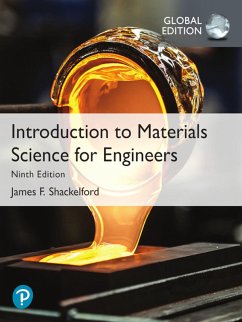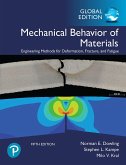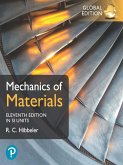Introduction to Materials Science for Engineers, Global Edition (eBook, PDF)


Alle Infos zum eBook verschenken

Introduction to Materials Science for Engineers, Global Edition (eBook, PDF)
- Format: PDF
- Merkliste
- Auf die Merkliste
- Bewerten Bewerten
- Teilen
- Produkt teilen
- Produkterinnerung
- Produkterinnerung

Hier können Sie sich einloggen

Bitte loggen Sie sich zunächst in Ihr Kundenkonto ein oder registrieren Sie sich bei bücher.de, um das eBook-Abo tolino select nutzen zu können.
For a first course in Materials Sciences and Engineering taught in the departments of materials science, mechanical, civil and general engineering.
Introduction to Materials Science for Engineers provides balanced, current treatment of the full spectrum of engineering materials, covering all the physical properties, applications and relevant properties associated with engineering materials. It explores all of the major categories of materials while also offering detailed examinations of a wide range of new materials with high-tech applications.
Revised to reflect recent data and trends,…mehr
- Geräte: PC
- ohne Kopierschutz
- eBook Hilfe
![Introduction to Engineering Materials (eBook, PDF) Introduction to Engineering Materials (eBook, PDF)]() George MurrayIntroduction to Engineering Materials (eBook, PDF)64,95 €
George MurrayIntroduction to Engineering Materials (eBook, PDF)64,95 €![Materials for Civil and Construction Engineers, SI Edition (eBook, PDF) Materials for Civil and Construction Engineers, SI Edition (eBook, PDF)]() Michael S. MamloukMaterials for Civil and Construction Engineers, SI Edition (eBook, PDF)42,95 €
Michael S. MamloukMaterials for Civil and Construction Engineers, SI Edition (eBook, PDF)42,95 €![Mechanical Behavior of Materials, Global Edition (eBook, PDF) Mechanical Behavior of Materials, Global Edition (eBook, PDF)]() Norman E. DowlingMechanical Behavior of Materials, Global Edition (eBook, PDF)42,95 €
Norman E. DowlingMechanical Behavior of Materials, Global Edition (eBook, PDF)42,95 €![Introduction to the Physics and Chemistry of Materials (eBook, PDF) Introduction to the Physics and Chemistry of Materials (eBook, PDF)]() Robert J. NaumannIntroduction to the Physics and Chemistry of Materials (eBook, PDF)171,95 €
Robert J. NaumannIntroduction to the Physics and Chemistry of Materials (eBook, PDF)171,95 €![An Introduction to Metallurgy, Second Edition (eBook, PDF) An Introduction to Metallurgy, Second Edition (eBook, PDF)]() Alan CottrellAn Introduction to Metallurgy, Second Edition (eBook, PDF)48,95 €
Alan CottrellAn Introduction to Metallurgy, Second Edition (eBook, PDF)48,95 €![Introduction to Materials Science and Engineering (eBook, PDF) Introduction to Materials Science and Engineering (eBook, PDF)]() Yip-Wah ChungIntroduction to Materials Science and Engineering (eBook, PDF)48,95 €
Yip-Wah ChungIntroduction to Materials Science and Engineering (eBook, PDF)48,95 €![Mechanics of Materials, eBook, SI Edition (eBook, PDF) Mechanics of Materials, eBook, SI Edition (eBook, PDF)]() Russell C. HibbelerMechanics of Materials, eBook, SI Edition (eBook, PDF)42,95 €
Russell C. HibbelerMechanics of Materials, eBook, SI Edition (eBook, PDF)42,95 €-
-
-
Introduction to Materials Science for Engineers provides balanced, current treatment of the full spectrum of engineering materials, covering all the physical properties, applications and relevant properties associated with engineering materials. It explores all of the major categories of materials while also offering detailed examinations of a wide range of new materials with high-tech applications.
Revised to reflect recent data and trends, the 9th Edition includes updated computer-generated crystal structure illustrations and new end-of-chapter conceptual problems.
Dieser Download kann aus rechtlichen Gründen nur mit Rechnungsadresse in A, B, BG, CY, CZ, D, DK, EW, E, FIN, F, GR, HR, H, IRL, I, LT, L, LR, M, NL, PL, P, R, S, SLO, SK ausgeliefert werden.
- Produktdetails
- Verlag: Pearson ITP
- Altersempfehlung: ab 18 Jahre
- Erscheinungstermin: 21. Oktober 2022
- Englisch
- ISBN-13: 9781292441023
- Artikelnr.: 66259222
- Verlag: Pearson ITP
- Altersempfehlung: ab 18 Jahre
- Erscheinungstermin: 21. Oktober 2022
- Englisch
- ISBN-13: 9781292441023
- Artikelnr.: 66259222
- Herstellerkennzeichnung Die Herstellerinformationen sind derzeit nicht verfügbar.
2. 1.1 The Material World
3. 1.2 Materials Science and Engineering
4. 1.3 Six Materials That Changed Your World
o STEEL BRIDGESINTRODUCING METALS
o TRANSPARENT OXIDESINTRODUCING CERAMICS
o SMARTPHONES AND TABLETSINTRODUCING GLASSES
o NYLON PARACHUTESINTRODUCING POLYMERS
o KEVLAR®-REINFORCED TIRESINTRODUCINGCOMPOSITES
o SILICON CHIPSINTRODUCING SEMICONDUCTORS
5. 1.4 Processing and Selecting Materials
6. 1.5 Looking at Materials by Powers of Ten
PARTI: The Fundamentals
1. Atomic Bonding
* 2.1 Atomic Structure
* 2.2 The Ionic Bond
* COORDINATION NUMBER
* 2.3 The Covalent Bond
* 2.4 The Metallic Bond
* 2.5 The Secondary, or van der Waals, Bond
* 2.6 MaterialsThe Bonding Classification
2. Crystalline StructurePerfection
* 3.1 Seven Systems and Fourteen Lattices
* 3.2 Metal Structures
* 3.3 Ceramic Structures
3. Crystal Defects and Noncrystalline StructureImperfection
* 4.1 The Solid SolutionChemical Imperfection
* 4.2 Point DefectsZero-Dimensional Imperfections
* 4.3 Linear Defects, or DislocationsOne-Dimensional Imperfections
* 4.4 Planar DefectsTwo-Dimensional Imperfections
* 4.5 Noncrystalline SolidsThree-Dimensional Imperfections
4. Diffusion
* 5.1 Thermally Activated Processes
* 5.2 Thermal Production of Point Defects
* 5.3 Point Defects and Solid-State Diffusion
* 5.4 Steady-State Diffusion
* 5.5 Alternate Diffusion Paths
5. Mechanical Behavior
* 6.1 Stress Versus Strain
* METALS
* CERAMICS AND GLASSES
* POLYMERS
* 6.2 Elastic Deformation
* 6.3 Plastic Deformation
* 6.4 Hardness
* 6.5 Creep and Stress Relaxation
* 6.6 Viscoelastic Deformation
* INORGANIC GLASSES
* ORGANIC POLYMERS
* ELASTOMERS
6. Thermal Behavior
* 7.1 Heat Capacity
* 7.2 Thermal Expansion
* 7.3 Thermal Conductivity
* 7.4 Thermal Shock
7. Failure Analysis and Prevention
* 8.1 Impact Energy
* 8.2 Fracture Toughness
* 8.3 Fatigue
* 8.4 Nondestructive Testing
* 8.5 Failure Analysis and Prevention
8. Phase DiagramsEquilibrium Microstructural Development
* 9.1 The Phase Rule
* 9.2 The Phase Diagram
* COMPLETE SOLID SOLUTION EUTECTIC DIAGRAM WITH NO SOLID SOLUTION
* EUTECTIC DIAGRAM WITH LIMITED SOLID SOLUTION
* EUTECTOID DIAGRAM
* PERITECTIC DIAGRAM
* GENERAL BINARY DIAGRAMS
* 9.3 The Lever Rule
* 9.4 Microstructural Development During Slow Cooling
9. TimeThe Third Dimension
* 10.1 TimeThe Third Dimension
* 10.2 The TTT Diagram
* DIFFUSIONAL TRANSFORMATIONS
* DIFFUSIONLESS (MARTENSITIC) TRANSFORMATIONS
* HEAT TREATMENT OF STEEL
* 10.3 Hardenability
* 10.4 Precipitation Hardening
* 10.5 Annealing
* COLD WORK
* RECOVERY
* RECRYSTALLIZATION
* GRAIN GROWTH
* 10.6 The Kinetics of Phase Transformations for Nonmetals
PART II: Materials and Their Applications
10. Structural MaterialsMetals, Ceramics, and Glasses
* 11.1 Metals
* FERROUS ALLOYS
* NONFERROUS ALLOYS
* 11.2 Ceramics and Glasses
* CERAMICSCRYSTALLINE MATERIALS
* GLASSESNONCRYSTALLINE MATERIALS
* GLASS-CERAMICS
* 11.3 Processing the Structural Materials
* PROCESSING OF METALS
* PROCESSING OF CERAMICS AND GLASSES
11. Structural MaterialsPolymers and Composites
* Polymers
* POLYMERIZATION
* STRUCTURAL FEATURES OF POLYMERS
* THERMOPLASTIC POLYMERS
* THERMOSETTING POLYMERS
* ADDITIVES
* 12.2 Composites
* FIBER-REINFORCED COMPOSITES
* AGGREGATE COMPOSITES
* PROPERTY AVERAGING
* MECHANICAL PROPERTIES OF COMPOSITES
* 12.3 Processing the Structural Materials
* PROCESSING OF POLYMERS
* PROCESSING OF COMPOSITES
12. Electronic Materials
* 13.1 Charge Carriers and Conduction
* 13.2 Energy Levels and Energy Bands
* 13.3 Conductors
* THERMOCOUPLES
* SUPERCONDUCTORS
* 13.4 Insulators
* FERROELECTRICS
* PIEZOELECTRICS
* 13.5 Semiconductors
* INTRINSIC, ELEMENTAL SEMICONDUCTORS
* EXTRINSIC, ELEMENTAL SEMICONDUCTORS
* COMPOUND SEMICONDUCTORS
* PROCESSING OF SEMICONDUCTORS
* SEMICONDUCTOR DEVICES
* 13.6 Composites
* 13.7 Electrical Classification of Materials
13. Optical and Magnetic Materials
* 14.1 Optical Materials
* OPTICAL PROPERTIES
* OPTICAL SYSTEMS AND DEVICES
* 14.2 Magnetic Materials
* FERROMAGNETISM
* FERRIMAGNETISM
* METALLIC MAGNETS
* CERAMIC MAGNETS
14. Materials in Engineering Design
* 15.1 Material PropertiesEngineering Design Parameters
* 15.2 Selection of Structural MaterialsCase Studies
* MATERIALS FOR HIP- AND KNEE-JOINT REPLACEMENT
* METAL SUBSTITUTION WITH COMPOSITES
* 15.3 Selection of Electronic, Optical, and Magnetic MaterialsCase
Studies
* LIGHT-EMITTING DIODE
* GLASS FOR SMART PHONE AND TABLET TOUCHSCREENS
* AMORPHOUS METAL FOR ELECTRIC-POWERDISTRIBUTION
* 15.4 Materials and Our Environment
* ENVIRONMENTAL DEGRADATION OF MATERIALS
* ENVIRONMENTAL ASPECTS OF DESIGN RECYCLING AND REUSE
* APPENDIX1: Physical and Chemical Data for the Elements
* APPENDIX 2: Atomic and Ionic Radii of the Elements
* APPENDIX 3: Constants and Conversion Factors and the Periodic Table
of Elements
* APPENDIX 4: Properties of the Structural Materials
* APPENDIX 5: Properties of the Electronic, Optical, and Magnetic
Materials
* APPENDIX 6: Glossary Answers to Practice Problems (PP) and
Odd-Numbered Problems Index
2. 1.1 The Material World
3. 1.2 Materials Science and Engineering
4. 1.3 Six Materials That Changed Your World
o STEEL BRIDGESINTRODUCING METALS
o TRANSPARENT OXIDESINTRODUCING CERAMICS
o SMARTPHONES AND TABLETSINTRODUCING GLASSES
o NYLON PARACHUTESINTRODUCING POLYMERS
o KEVLAR®-REINFORCED TIRESINTRODUCINGCOMPOSITES
o SILICON CHIPSINTRODUCING SEMICONDUCTORS
5. 1.4 Processing and Selecting Materials
6. 1.5 Looking at Materials by Powers of Ten
PARTI: The Fundamentals
1. Atomic Bonding
* 2.1 Atomic Structure
* 2.2 The Ionic Bond
* COORDINATION NUMBER
* 2.3 The Covalent Bond
* 2.4 The Metallic Bond
* 2.5 The Secondary, or van der Waals, Bond
* 2.6 MaterialsThe Bonding Classification
2. Crystalline StructurePerfection
* 3.1 Seven Systems and Fourteen Lattices
* 3.2 Metal Structures
* 3.3 Ceramic Structures
3. Crystal Defects and Noncrystalline StructureImperfection
* 4.1 The Solid SolutionChemical Imperfection
* 4.2 Point DefectsZero-Dimensional Imperfections
* 4.3 Linear Defects, or DislocationsOne-Dimensional Imperfections
* 4.4 Planar DefectsTwo-Dimensional Imperfections
* 4.5 Noncrystalline SolidsThree-Dimensional Imperfections
4. Diffusion
* 5.1 Thermally Activated Processes
* 5.2 Thermal Production of Point Defects
* 5.3 Point Defects and Solid-State Diffusion
* 5.4 Steady-State Diffusion
* 5.5 Alternate Diffusion Paths
5. Mechanical Behavior
* 6.1 Stress Versus Strain
* METALS
* CERAMICS AND GLASSES
* POLYMERS
* 6.2 Elastic Deformation
* 6.3 Plastic Deformation
* 6.4 Hardness
* 6.5 Creep and Stress Relaxation
* 6.6 Viscoelastic Deformation
* INORGANIC GLASSES
* ORGANIC POLYMERS
* ELASTOMERS
6. Thermal Behavior
* 7.1 Heat Capacity
* 7.2 Thermal Expansion
* 7.3 Thermal Conductivity
* 7.4 Thermal Shock
7. Failure Analysis and Prevention
* 8.1 Impact Energy
* 8.2 Fracture Toughness
* 8.3 Fatigue
* 8.4 Nondestructive Testing
* 8.5 Failure Analysis and Prevention
8. Phase DiagramsEquilibrium Microstructural Development
* 9.1 The Phase Rule
* 9.2 The Phase Diagram
* COMPLETE SOLID SOLUTION EUTECTIC DIAGRAM WITH NO SOLID SOLUTION
* EUTECTIC DIAGRAM WITH LIMITED SOLID SOLUTION
* EUTECTOID DIAGRAM
* PERITECTIC DIAGRAM
* GENERAL BINARY DIAGRAMS
* 9.3 The Lever Rule
* 9.4 Microstructural Development During Slow Cooling
9. TimeThe Third Dimension
* 10.1 TimeThe Third Dimension
* 10.2 The TTT Diagram
* DIFFUSIONAL TRANSFORMATIONS
* DIFFUSIONLESS (MARTENSITIC) TRANSFORMATIONS
* HEAT TREATMENT OF STEEL
* 10.3 Hardenability
* 10.4 Precipitation Hardening
* 10.5 Annealing
* COLD WORK
* RECOVERY
* RECRYSTALLIZATION
* GRAIN GROWTH
* 10.6 The Kinetics of Phase Transformations for Nonmetals
PART II: Materials and Their Applications
10. Structural MaterialsMetals, Ceramics, and Glasses
* 11.1 Metals
* FERROUS ALLOYS
* NONFERROUS ALLOYS
* 11.2 Ceramics and Glasses
* CERAMICSCRYSTALLINE MATERIALS
* GLASSESNONCRYSTALLINE MATERIALS
* GLASS-CERAMICS
* 11.3 Processing the Structural Materials
* PROCESSING OF METALS
* PROCESSING OF CERAMICS AND GLASSES
11. Structural MaterialsPolymers and Composites
* Polymers
* POLYMERIZATION
* STRUCTURAL FEATURES OF POLYMERS
* THERMOPLASTIC POLYMERS
* THERMOSETTING POLYMERS
* ADDITIVES
* 12.2 Composites
* FIBER-REINFORCED COMPOSITES
* AGGREGATE COMPOSITES
* PROPERTY AVERAGING
* MECHANICAL PROPERTIES OF COMPOSITES
* 12.3 Processing the Structural Materials
* PROCESSING OF POLYMERS
* PROCESSING OF COMPOSITES
12. Electronic Materials
* 13.1 Charge Carriers and Conduction
* 13.2 Energy Levels and Energy Bands
* 13.3 Conductors
* THERMOCOUPLES
* SUPERCONDUCTORS
* 13.4 Insulators
* FERROELECTRICS
* PIEZOELECTRICS
* 13.5 Semiconductors
* INTRINSIC, ELEMENTAL SEMICONDUCTORS
* EXTRINSIC, ELEMENTAL SEMICONDUCTORS
* COMPOUND SEMICONDUCTORS
* PROCESSING OF SEMICONDUCTORS
* SEMICONDUCTOR DEVICES
* 13.6 Composites
* 13.7 Electrical Classification of Materials
13. Optical and Magnetic Materials
* 14.1 Optical Materials
* OPTICAL PROPERTIES
* OPTICAL SYSTEMS AND DEVICES
* 14.2 Magnetic Materials
* FERROMAGNETISM
* FERRIMAGNETISM
* METALLIC MAGNETS
* CERAMIC MAGNETS
14. Materials in Engineering Design
* 15.1 Material PropertiesEngineering Design Parameters
* 15.2 Selection of Structural MaterialsCase Studies
* MATERIALS FOR HIP- AND KNEE-JOINT REPLACEMENT
* METAL SUBSTITUTION WITH COMPOSITES
* 15.3 Selection of Electronic, Optical, and Magnetic MaterialsCase
Studies
* LIGHT-EMITTING DIODE
* GLASS FOR SMART PHONE AND TABLET TOUCHSCREENS
* AMORPHOUS METAL FOR ELECTRIC-POWERDISTRIBUTION
* 15.4 Materials and Our Environment
* ENVIRONMENTAL DEGRADATION OF MATERIALS
* ENVIRONMENTAL ASPECTS OF DESIGN RECYCLING AND REUSE
* APPENDIX1: Physical and Chemical Data for the Elements
* APPENDIX 2: Atomic and Ionic Radii of the Elements
* APPENDIX 3: Constants and Conversion Factors and the Periodic Table
of Elements
* APPENDIX 4: Properties of the Structural Materials
* APPENDIX 5: Properties of the Electronic, Optical, and Magnetic
Materials
* APPENDIX 6: Glossary Answers to Practice Problems (PP) and
Odd-Numbered Problems Index







